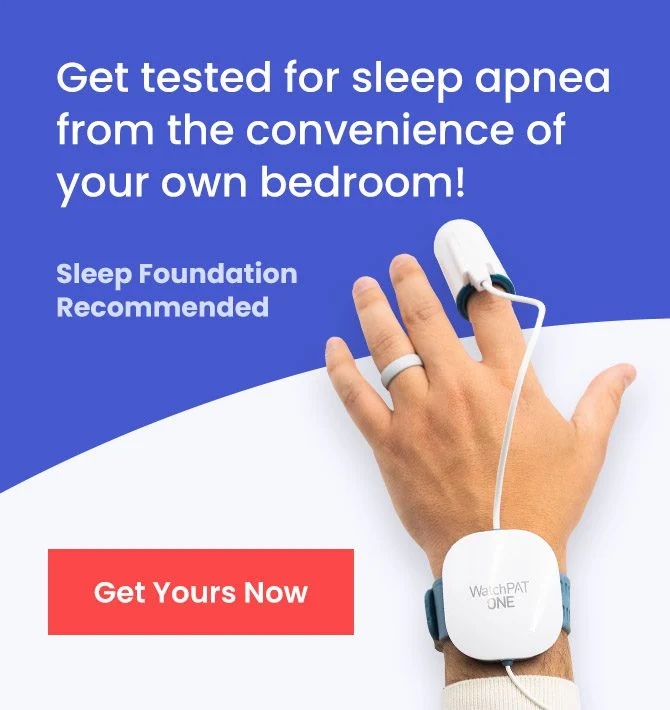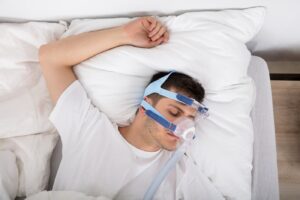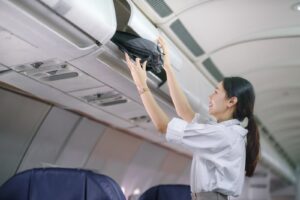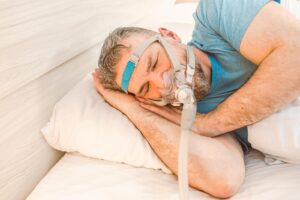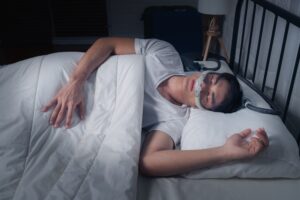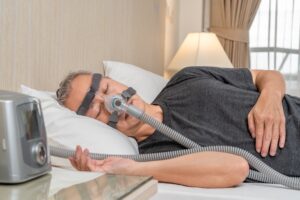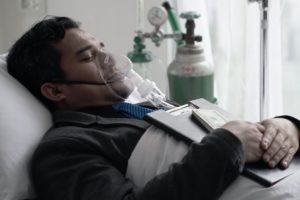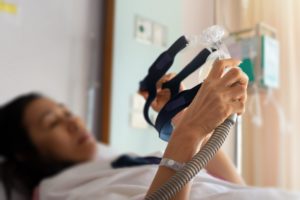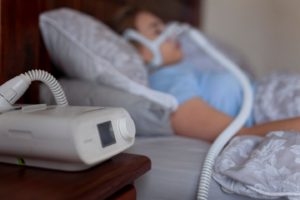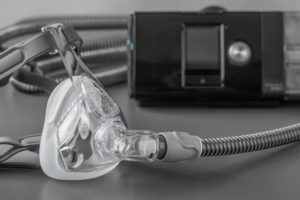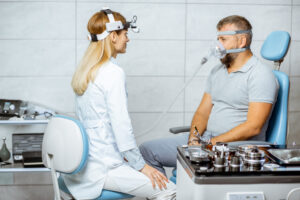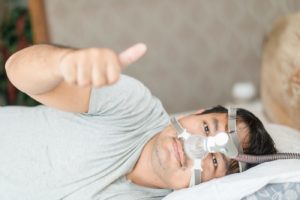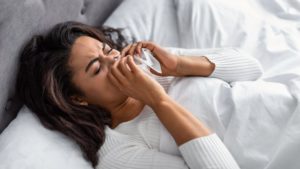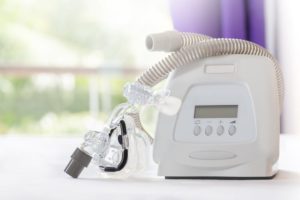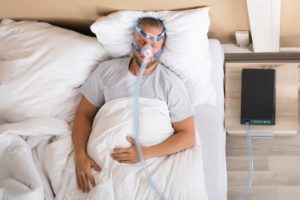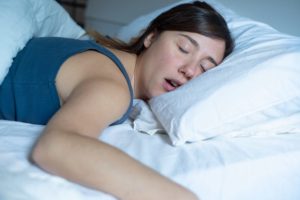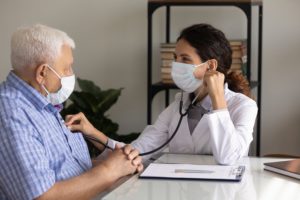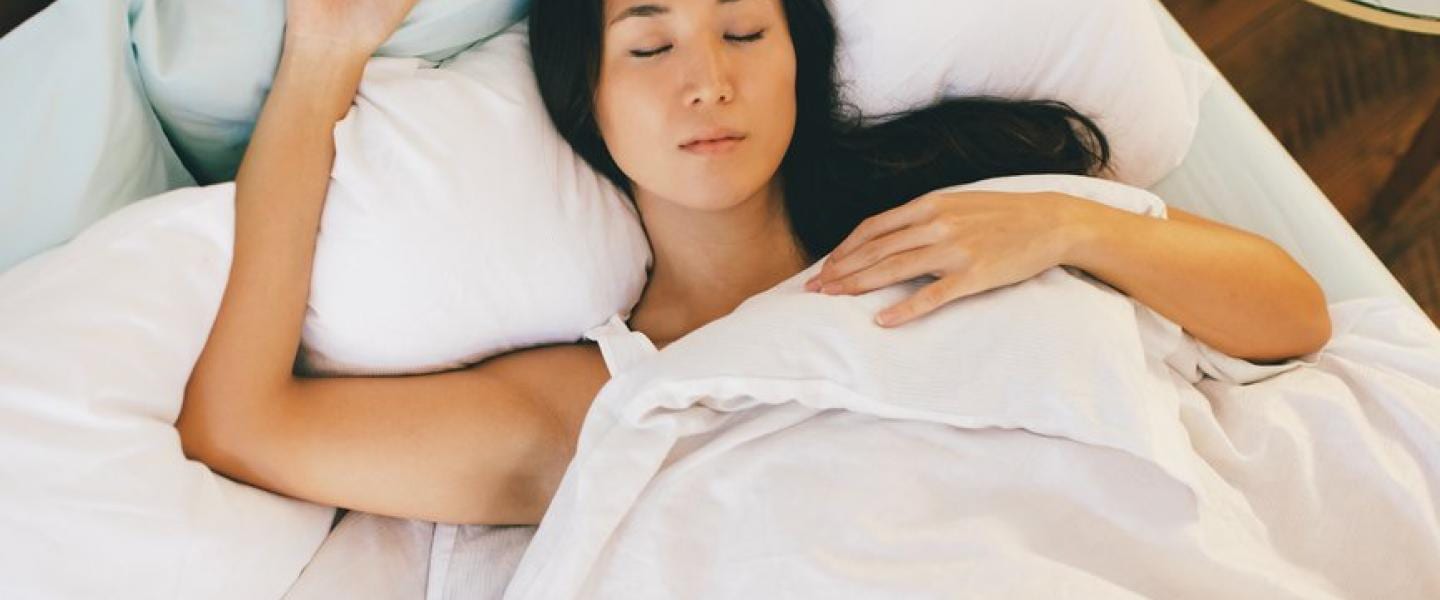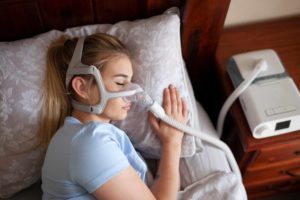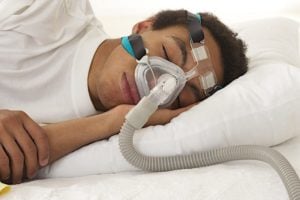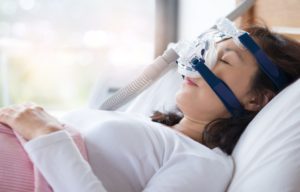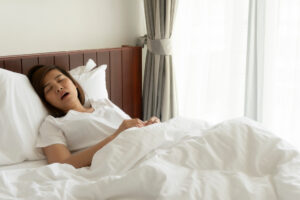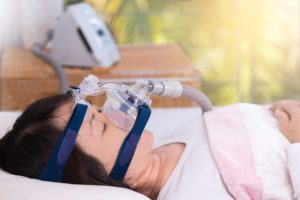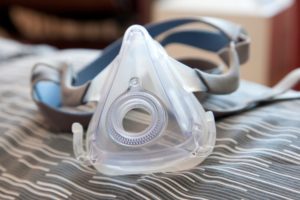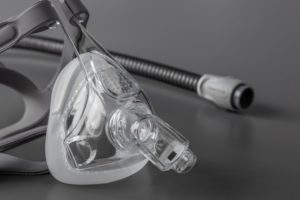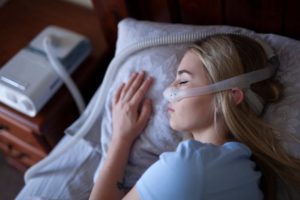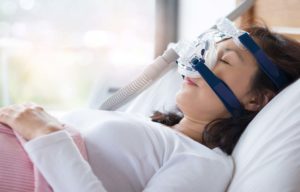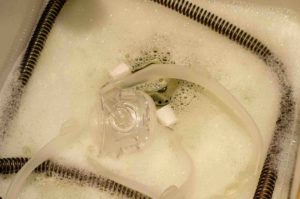When you buy through our links, we may earn a commission. Products or services may be offered by an affiliated entity. Learn more.
How Do I Purchase a CPAP Machine?
People with obstructive sleep apnea (OSA) have difficulty breathing while sleeping due to blocked airways. While fairly common, OSA can have serious consequences like daytime sleepiness, reduced work productivity, and cardiovascular disease. Loud snoring and not feeling rested the next day may point to sleep apnea. Risk factors for OSA include being overweight, nasal congestion, smoking, and alcohol use.
Continuous positive airway pressure (CPAP) therapy is often prescribed for OSA and can be a very effective treatment. During CPAP therapy, a small machine pumps pressurized air through a tube and mask to help keep your airways open.
If you’ve been prescribed CPAP therapy for your sleep apnea, you’ll need to purchase a CPAP machine based on your doctor’s recommendations. We’ll discuss how to find and buy an appropriate model. We’ll also go over insurance coverage and CPAP accessories to help you get the most out of your therapy.
Obtain a Prescription for Obstructive Sleep Apnea
A CPAP machine can only be purchased with a prescription from a doctor or sleep specialist. If you suspect you have sleep apnea, talk to your health care team to come up with a plan for diagnosis.
Methods for OSA Diagnosis
Obstructive sleep apnea is diagnosed using a sleep study, which evaluates your heart rate, blood oxygen levels, breathing patterns, and how frequently you stop breathing or wake up during the night. As the name suggests, the data is measured while you’re sleeping.
Two types of sleep studies are used to diagnose OSA: nocturnal polysomnography (PSG) and at-home sleep apnea tests.
- Nocturnal Polysomnography (PSG) Test: This study is performed at a hospital or sleep center. It involves using various sensors to measure breathing and heart rate, oxygen levels, brain waves, and eye and leg movements while you sleep. If this test leads to a sleep apnea diagnosis, a CPAP titration study is usually the next step. This is similar to a PSG except that a sleep technologist monitors your vitals while you use a CPAP machine. The goal is to determine the lowest pressure setting needed to keep your airways unobstructed.
- At-Home Sleep Apnea Tests: An at-home sleep apnea test collects similar information to a PSG but is performed in the comfort of your own home. The test involves using a small monitor to record your breathing patterns, oxygen levels, and heart rate. The results should include your OSA severity score, also known as the apnea-hypopnea index (AHI). This score is based on your number of apneas, or how many times you stop breathing per hour. Once you have this score, a CPAP titration study will likely be the next step. At-home tests can’t provide the same depth of information as a PSG test, but they are a lower-cost option.
Who Can Prescribe a CPAP Machine?
Whether you get diagnosed in a sleep lab or do an at-home sleep study, your CPAP machine will require a prescription. A sleep specialist will analyze your test results and send them to your doctor for review. Your doctor can then recommend the best CPAP machine and mask based on your data.
Follow Your Doctor’s Recommendations
Your physician will recommend the best type of positive airway pressure therapy (PAP) for you based on the results of your sleep study. While a CPAP machine is usually the first choice for sleep apnea, other PAP devices like bi-level positive airway pressure (BiPAP) and auto-titrating positive airway pressure (APAP) are also sometimes prescribed.
If you receive a prescription for CPAP therapy, you will need to follow your doctor’s instructions when it comes to pressure settings. There will likely be more than one model to suit your needs, and sometimes you can buy a CPAP machine, a mask, or both directly from a sleep clinic or physician’s office.
If you decide to purchase these elsewhere, always double check that specs and features comply with your doctor’s recommendations. Important information like pressure and ramp settings, as well as auto features, can be found on product packaging or the manufacturer’s website.
Take Our Quiz to Know Your Sleep Apnea Risk
To understand if you could have sleep apnea, take our short quiz below to see if you exhibit any signs.
Check Health Insurance Coverage
Most health insurance plans at least partially cover the cost of CPAP machines, which fall under the durable medical equipment category. Providers will usually refer to your apnea-hypopnea index (AHI) to determine eligibility and coverage, as the index reflects the seriousness of your condition. Depending on your plan, you might have to meet your minimum deductible before your CPAP equipment is covered.
Bear in mind that you may have limited options when obtaining a machine through your insurance provider. Some plans reimburse the entire cost of the machine, but partial coverage is more common for CPAP accessories like masks, tubing, and filters. Other providers require that you rent a machine for a certain amount of time before purchasing.
Insurers sometimes monitor CPAP adherence, or how often you use the device. Machines store usage data, which is then shared with insurance companies. Your provider may terminate coverage or ask that you return the device if you fail to maintain regular CPAP therapy.
Does Medicare Cover CPAP Machine Costs?
OSA patients with Medicare are typically eligible for a three-month trial period that includes devices and accessories. Coverage may continue after the trial if your doctor concludes that CPAP therapy is improving your condition.
Once you meet the Plan B deductible, Medicare covers 80% of the machine rental and purchase of accessories like masks and tubing. You’ll own the machine once you meet adherence requirements for 13 consecutive months.
Your machine is only covered if your doctor and supplier is enrolled in Medicare. Some suppliers also require that you pay both your share and Medicare’s upfront, in which case you’d need to submit a reimbursement claim.
Locate a CPAP Retailer
Once you’ve obtained a prescription, you can purchase a CPAP machine through your insurance provider, a local clinic, a third-party retailer, or directly from the manufacturer. Each option has its pros and cons.
- Your Health Insurer Purchasing directly from your health insurance provider removes the guesswork from coverage options, but you’re limited to only certain machines. Be prepared to supply your prescription and sleep study results. Your provider will also track your usage data to ensure that you’re complying with therapy guidelines. If you have a very high deductible plan, purchasing from your insurance company may not be the most cost-effective route. It might be cheaper to buy both the machine and the accessories from a retailer. This would likely give you more models to choose from.
- Local Sleep Clinic If you had a PSG at a sleep clinic, it might be easiest to buy a device directly from them. The clinic can recommend a model based on your sleep study, and you’ll be able to try on different kinds of masks in person. You will also have the benefit of professional guidance, and you can often do a test run of the device to make sure you’re using it properly.
- Local Medical Supply Store Like buying from a sleep clinic, buying from a local medical supply store allows you to get a better sense of the style and size of the machine, mask, and accessories. Retail associates can make suggestions based on your doctor’s prescription and the details of your sleep study. It’s also often easier to make returns in person if the model isn’t the right fit.
- Online Options Purchasing a CPAP machine online gives you the widest range of options. It’s also easier to comparison shop and locate the best deal for your needs. Make sure to only purchase from a reputable retailer or directly from the manufacturer, as some websites sell devices that aren’t FDA-compliant. Always check to see if a model has a sleep trial or return policy. You will need to either email, fax, or upload your prescription at checkout when buying online.
Consider Your CPAP Accessories
CPAP machines require certain accessories like face masks and tubing. Other components are optional but may enhance comfort and performance.
Finding a suitable mask is critical to successful therapy. The mask creates a secure seal over the user’s nose or nose and mouth to prevent air leaks. There are three main types: nasal, nasal pillow, and full-face. Your doctor can recommend a style based on factors like sleep position and breathing style.
While most CPAP machines are sold on their own, manufacturers often offer bundles that include masks, hoses, and filters. Replacement parts and optional accessories like humidifiers and cleaning solutions are generally sold separately.
Essential CPAP Accessories
Masks, hoses, and filters are all fundamental to operating a CPAP machine. Each provides a different and equally important function when it comes to delivering PAP therapy.
CPAP Masks
A CPAP mask incorporates three components: a frame, cushion, and headgear.
The frame is what connects the cushion, tubing, and headgear to create a secure fit over the user’s face. Frames come in different designs and sizes to accommodate varying head shapes, sleep positions, and breathing styles. Full-face masks, nasal pillows, and nasal masks are the most common types.
A cushion creates a seal over the user’s mouth and nose to prevent air leaks, while nasal pillows do the same for only the nostrils. Cushions and nasal pillows come in different sizes and are made from soft and flexible materials like silicone.
Headgear includes adjustable straps that fit around your head to secure the mask. They usually attach to the mask via velcro or clips.
CPAP Hoses
A CPAP machine pumps pressurized air through a hose that’s connected to a mask. Hoses come in non-heated and heated options. Heated hoses are designed to humidify pressurized air and reduce condensation. They can minimize symptoms associated with dryness, like nosebleeds and sore throats.
CPAP Filters
A filter purifies the air, protecting both you and your CPAP machine. Filters are designed to prevent mold, pollen, dust mites, and other contaminants from entering your lungs while you use your machine.
Filters come in disposable and non-disposable options. Some machines are only compatible with one type of filter, while others accommodate both. People with allergies or recurring sinus infections may want to opt for in-line bacteria filters. These disposable, ultra-fine filters collect bacteria and viruses before they enter your mask.
Optional CPAP Accessories
While not strictly necessary, some CPAP accessories like mask liners and humidifiers can enhance user comfort and compliance. Optional components aren’t usually included with CPAP bundles but can be purchased separately.
Not all accessories are compatible with every CPAP machine. Always refer to the product manual for your machine before purchasing additional accessories.
CPAP Mask Liners
A mask liner provides a comfortable fabric barrier between your face and your mask. Liners can offer much needed relief for people who experience skin irritation or indentation marks with CPAP masks. Liners can also reduce air leaks by helping you achieve a snug fit.
Humidifiers
CPAP therapy can dry out the nasal passages, causing side effects like nosebleeds, dry mouth, and sore throats. Humidifiers use a water tank filled with distilled water to moisturize the air. Optimizing air moisture can alleviate symptoms caused by excessive dryness.
Some CPAP machines have built-in humidifiers, while others are external. Similar to CPAP hoses, humidifiers can be non-heated or heated. Heated humidifiers add warmth and moisture to the pressurized air and can benefit those living in dry climates.
Humidifier Reservoir Replacements
Cleaning the humidifier reservoir daily is crucial to preventing bacterial growth. The water chamber should be replaced about every six months, or sooner if it starts to show discoloration or other signs of wear. Most CPAP manufacturers sell replacement parts like water chambers.
Heated CPAP Hoses
Heated hoses increase air temperature by using an electric current. Like a humidifier, heated hoses are intended to reduce symptoms related to dryness. Users can adjust the temperature based on their dryness levels and ambient room temperature. Heating hoses can also prevent excessive condensation, known as “rainout.” Excess moisture in the hose can leak into your mask and cushion, which can be annoying and uncomfortable.
Hoses should be replaced about every three months.
CPAP Cleaners
CPAP equipment can usually be cleaned with mild dish soap, vinegar, and warm water. There are also sanitizers designed specifically for CPAP components, but they can be quite pricey. Furthermore, these cleaning solutions aren’t necessarily more effective at killing bacteria and other contaminants. Water-free CPAP cleaners are particularly controversial and are not FDA-approved.
Always refer to the manufacturer’s manual, as cleaning instructions vary according to model and component. Regular equipment cleaning is essential to healthy and effective CPAP therapy.
Chinstraps
A chinstrap is an elasticized band that helps keep your mouth shut while you sleep. They are especially helpful at preventing air leaks for mouth breathers who wear nasal masks.
CPAP Pillows
CPAP pillows are pillows designed with cut-outs that make wearing a mask more comfortable. Some are shaped specifically for side sleepers so that the mask doesn’t cause painful facial indentations during the night. Others are more geared toward support and stability to prevent air leaks.
A CPAP pillow is not the same as a nasal pillow, which is a type of CPAP mask.
CPAP Batteries
CPAP machines generally require an electrical outlet to operate, but some models work with external batteries. Deep cycle and lithium-ion batteries are popular options that make CPAP therapy possible while camping or away from home.

Still have questions?
Our product experts have extensive experience testing just about every sleep product on the market. Send an email to [email protected] or call us at (877) 672-8966 with your questions and we’ll help you find exactly what you’re looking for.


